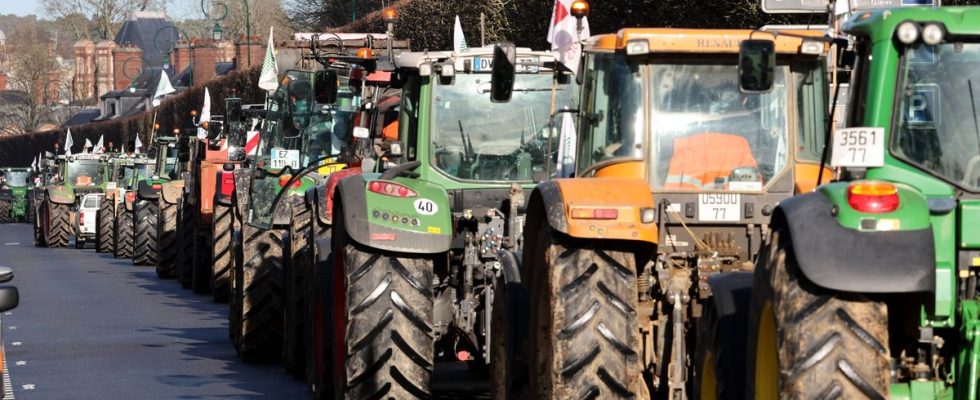Many European farmers, particularly in France but also in Germany, are angry. In their sights: the new EU Common Agricultural Policy. Complex ecological standards or those varying depending on the country, inflation, climatic episodes, unfair imports: the discontent of the agricultural world points to the limits of this CAP applied since 2023 and which runs until 2027.
If the European Commission has launched a “strategic dialogue” with the sector to prepare the post-2027 CAP, the possibilities of adjusting the current framework are debated. While the FNSEA announces a “week of all dangers” from this Monday, 20 minutes takes stock of the sources of discontent linked to Brussels’ choices.
Greening the CAP
Recent demonstrations in Europe denounce an “administrative burden”, while since last year the new CAP has made direct payments of European aid conditional on the application of environmental criteria.
Crop rotation, meadows, soil erosion, buffer strips near rivers, protection of wetlands and peat bogs or obligation of 4% fallow or non-productive areas (groves, ditches, ponds, hedges, with strict rules)… so many elements that have become restrictive. To which are added “eco-regimes”, additional bonuses for farmers voluntarily adopting more demanding practices (organic, carbon storage, agroecology, etc.). Farmers and elected officials denounce compliance checks that are sometimes too meticulous, for these criteria leading to new non-productive expenses and an excess of forms.
The fallow obligation
Concerning the fallow obligation, around ten countries had called in vain for the continuation of the exemption granted by Brussels in 2023 in the face of the impact of the Ukrainian conflict. Bulgaria requested it again last week, while French Minister Marc Fesneau announced his intention to “go to the European level to unblock a certain number of subjects” including “fallow land”.
The CAP, however, has not integrated the subsequent regulations of the Green Deal – of which those affecting agriculture are not yet in force, or even bogged down.
Flaws in the single market
Whether it concerns ecological criteria or redistributive measures, Member States have “flexibilities” in the way they apply the CAP, with very variable administrative complexity. “The pendulum has tilted towards flexibilities in the last reform, very clearly when we cross borders, we do the splits”, at the risk of “unfair competition on the internal market”, estimates Luc Vernet, of the Farm Europe think-tank . Especially since certain countries – such as France on pesticides – adopt stricter criteria than certain neighbors.
“There are overtranspositions” of texts “which have put French farmers in a situation of risk, of unfair competition in relation to their European colleagues,” recognized Marc Fesneau.
Customs agreements criticized
The demonstrations revive criticism against the free trade agreements concluded by Brussels, in particular the one with New Zealand ratified at the end of 2023, and the one in negotiations with the South American Mercosur countries. “In times of crisis, the Commission’s haste in wanting to sign with Mercosur is scandalous,” annoys Renew MEP (Liberals) Jérémy Decerle, echoing Paris’ opposition.
Discontent is also growing against the exemption from customs tariffs granted in 2022 to Ukrainian agricultural products, and which the Commission should extend after June. Cereals, mass-raised chickens, sugar… the sector denounces this “distorted” competition. “The Commission must do its regulatory work to stabilize markets and agricultural incomes,” says socialist MEP Christophe Clergeau, denouncing “laisser-faire” in the face of imports and deeming a “reorientation” “inevitable.”
“The changes necessary to counter climatic, environmental and food challenges are impossible when you are forced to produce at low prices for a globalized and deregulated market,” summarizes the alternative peasant federation Via Campesina.
A budgetary erosion
The CAP represents the largest item in the EU budget, with 387 billion euros over seven years (2021-2027), including 270 billion in direct aid. “But there is a gap between the decision on the CAP and its implementation, the costs having exploded (fuels, fertilizers, etc.) after the war in Ukraine,” worries MEP Anne Sander (PPE, right), further deploring that this budget is also requested for other policies such as the Green Deal. However, the multi-annual budget approved at the end of 2020 is “melting like snow in the sun” due to an inflationary surge drastically eating into the real value of aid, warns Farm Europe.
A crisis reserve deemed insufficient
The new CAP makes the “crisis reserve” a permanent instrument, with its own budget of 450 million euros to help farmers in the event of price instability. Faced with Ukrainian imports and the multiplication of climatic episodes, Brussels announced in mid-2023 its activation for all Twenty-Seven. “But its level remains very insufficient to be effective,” recently insisted the Commissioner for Agriculture, Janusz Wojciechowski.
While indebted farmers are “exposed to the blows of firedamp from the markets”, “if we want them to invest in transitions, we must reduce stress” in the face of unforeseen events with a “sufficient and responsive” reserve, notes Luc Vernet, judging the necessary level of “at least 1.5 billion euros”.

